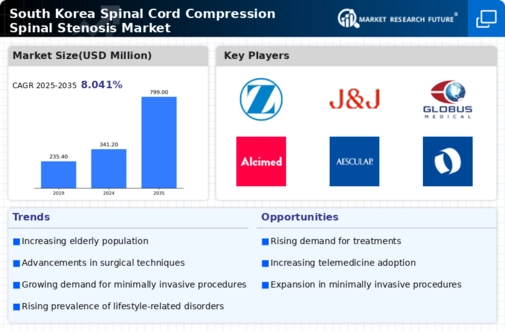Growing Geriatric Population
The demographic shift towards an aging population in South Korea is likely to have a profound impact on the spinal cord-compression-spinal-stenosis market. As individuals age, the incidence of spinal disorders tends to increase, leading to a higher demand for treatment options. This trend indicates that healthcare providers may need to adapt their services to cater to the specific needs of older patients. The rising geriatric population may also prompt further research into age-related spinal conditions, potentially leading to the development of specialized therapies. Consequently, the spinal cord-compression-spinal-stenosis market could experience significant growth as the population ages and the need for effective treatments escalates.
Increase in Healthcare Expenditure
Healthcare expenditure in South Korea has been on the rise, which may positively impact the spinal cord-compression-spinal-stenosis market. With the government allocating more funds towards healthcare services, there is a potential for improved access to advanced treatment options for spinal disorders. This increase in funding could facilitate the development of new therapies and technologies, thereby enhancing patient care. Additionally, as healthcare facilities upgrade their equipment and expand their services, the market may see a corresponding growth in the number of procedures performed. The overall increase in healthcare expenditure suggests a favorable environment for the spinal cord-compression-spinal-stenosis market to thrive.
Advancements in Surgical Techniques
The spinal cord-compression-spinal-stenosis market in South Korea is witnessing advancements in surgical techniques, which may enhance treatment outcomes for patients. Minimally invasive procedures, such as endoscopic spine surgery, are gaining traction due to their reduced recovery times and lower complication rates. These innovations are likely to attract more patients seeking effective solutions for spinal stenosis. Furthermore, the introduction of robotic-assisted surgeries could potentially improve precision and reduce the risk of errors during operations. As these advanced surgical options become more widely available, the market may experience an uptick in demand, leading to increased investments in surgical technologies and training for healthcare professionals.
Rising Awareness of Spinal Disorders
In South Korea, there is a growing awareness regarding spinal disorders, particularly spinal cord compression and spinal stenosis. This heightened awareness is likely to drive demand for diagnostic and therapeutic solutions within the spinal cord-compression-spinal-stenosis market. Educational campaigns and health initiatives by both governmental and non-governmental organizations have contributed to this trend. As a result, patients are increasingly seeking medical advice and treatment options, which may lead to a rise in consultations and procedures. The market could see a potential increase in revenue as more individuals become informed about their conditions and the available treatments. This trend suggests that the spinal cord-compression-spinal-stenosis market may experience significant growth as awareness continues to expand.
Enhanced Diagnostic Imaging Technologies
The introduction of enhanced diagnostic imaging technologies in South Korea is poised to transform the spinal cord-compression-spinal-stenosis market. Advanced imaging modalities, such as MRI and CT scans, allow for more accurate diagnosis and assessment of spinal conditions. This improvement in diagnostic capabilities may lead to earlier detection of spinal stenosis and related disorders, facilitating timely intervention. As healthcare providers increasingly adopt these technologies, the market may witness a surge in diagnostic procedures, which could subsequently drive demand for treatment options. The integration of cutting-edge imaging technologies suggests a promising future for the spinal cord-compression-spinal-stenosis market, as it enhances the overall quality of patient care.




















Leave a Comment